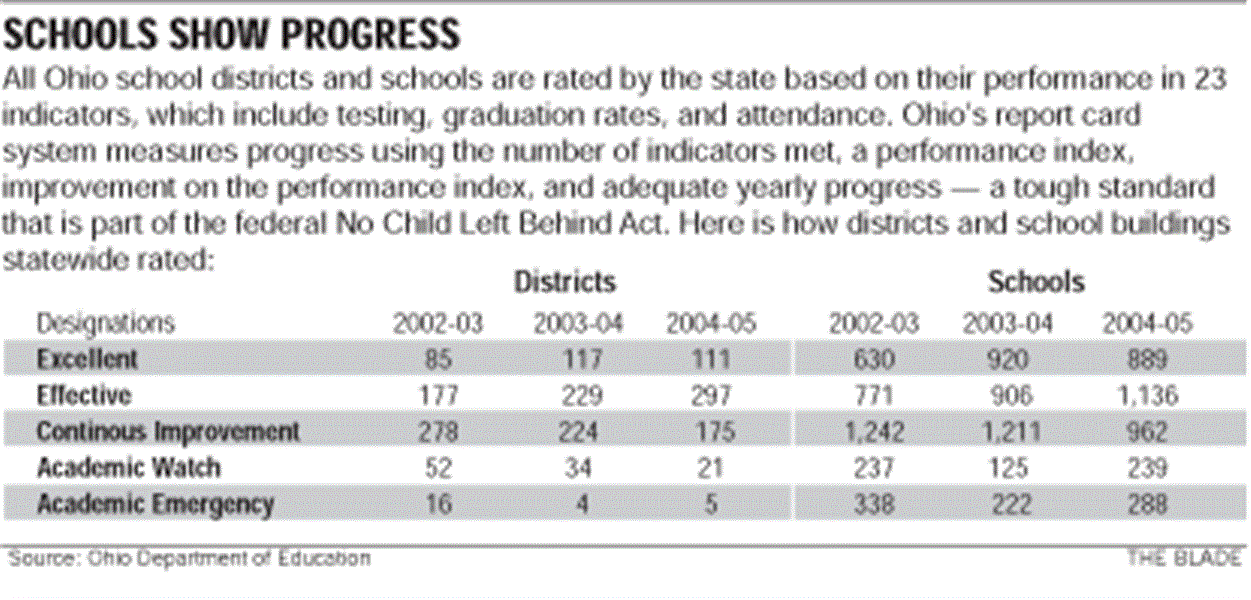
Ohio's test scores continue to improve, but big problems remain
8/16/2005

Continuing a five-year upward trend, average student test scores in Ohio increased over last year, state education officials said yesterday.
But at the same time, officials admitted the state's schools face significant challenges, such as closing the achievement gap between white and minority children - especially in math and graduation rates.
In addition, fewer schools last year were able to meet a tough federal standard that measures progress in subgroups of students. State officials, as in the old song, accentuated the positive.
"Once again, we are seeing improvement and achievement across the state," Mitchell Chester, Ohio's associate superintendant for policy and accountability, said of the latest data. "As we look at school districts, five out of every six school districts showed improvement in their performance index scores."
Statewide, the performance index climbed from 86.6 in 2003-2004 to 90.8 in 2004-2005. The index, a composite of test scores, is one of four measures the Ohio Department of Education uses to recognize improvement. The highest possible index score is 120, and for the first time, this year's index includes high school results.
Along with the index, the state uses improvement on the performance index, 23 state report card indicators, and the federal adequate yearly progress goals to determine what each district and school will be rated.
The Ohio Department of Education released annual statewide performance data yesterday. Information about the performance of individual schools and school districts statewide is scheduled to be released this morning.

However, state officials noted yesterday that five districts in the state are now in academic emergency, compared to four last year and 16 during the 2002-2003 academic year. Twenty-one districts are in academic watch, down from 34 last year and 52 for the 2002-2003 school year.
The top designation of excellent was attained by 111 districts, down from 117 last year; 297 districts are now rated effective, up from 229 last year; 175 are rated continuous improvement, down from 224 last year.
"Clearly one of the key pieces for Ohio are the designations we give schools," Mr. Chester said. "We are again seeing Ohio districts move up. Almost 96 percent of districts are rated excellent, effective, or continuous improvement."
He blamed the rating drop some districts experienced and the fact that fewer schools achieved the federal adequate yearly progress goal on the number of new exams given this year.
The federal No Child Left Behind Act requires Ohio to set adequate yearly progress goals and raise the bar in gradual increments so that all of Ohio's students are proficient on state reading and mathematics assessments by the 2013-2014 school year.
This year, 24.3 percent missed the federal standard, up from 17 percent last year.
"There is no question, raising the bar on the goals for AYP has had that impact," Mr. Chester said.
There are 23 report card indicators this year, including the achievement and proficiency tests in third through eighth grade, the Ohio Graduation Tests in five subjects, and graduation and attendance rates.
The state considers an indicator met if 75 percent or more of students taking the test are at least proficient. For graduation, the standard is 90 percent and for attendance, it is 93 percent.
This year's 10th graders - the first class required to pass all five sections of the OGT to receive a high school diploma - met the state standard in four out of five subjects. Just under 65 percent of students passed all five subjects on the first attempt.
Mr. Chester said the statewide results were cause to celebrate, but also noted the results were bittersweet.
Broken down by race, 70.5 percent of white students passed all five subjects, while 42 percent of Hispanics passed all five subjects and only 30.9 percent of African-American students passed the exam.
The same kind of discrepancies are seen in lower grade tests. Results of the seventh grade math test show 65.7 percent of white students passed, compared to 39.7 percent of Hispanics, 27 percent of black, and 37.3 percent of low-income students.
Toledo Public Schools, the region's largest school district, expects to receive confirmation today that it will retain the continuous improvement rating for the second consecutive year.
Toledo Superintendent Eugene Sanders said TPS has made strides.
"Part of the challenge, with regard to the seventh-grade math achievement test, is that is the first time that test was given, so it offers what I call baseline data - this is your starting point," he said. "You have to acknowledge that there are differences that exist among racial and ethnic groups and we have been able to do that over the last five years here in Toledo."
The statewide graduation rate increased again to 85.9 percent for the 2003-2004 school year - up from 84.3 percent the previous year.
That data lag a year behind so the state can count students who need summer school to receive a diploma.
Contact Ignazio Messina at:
imessina@theblade.com
or 419-724-6171.